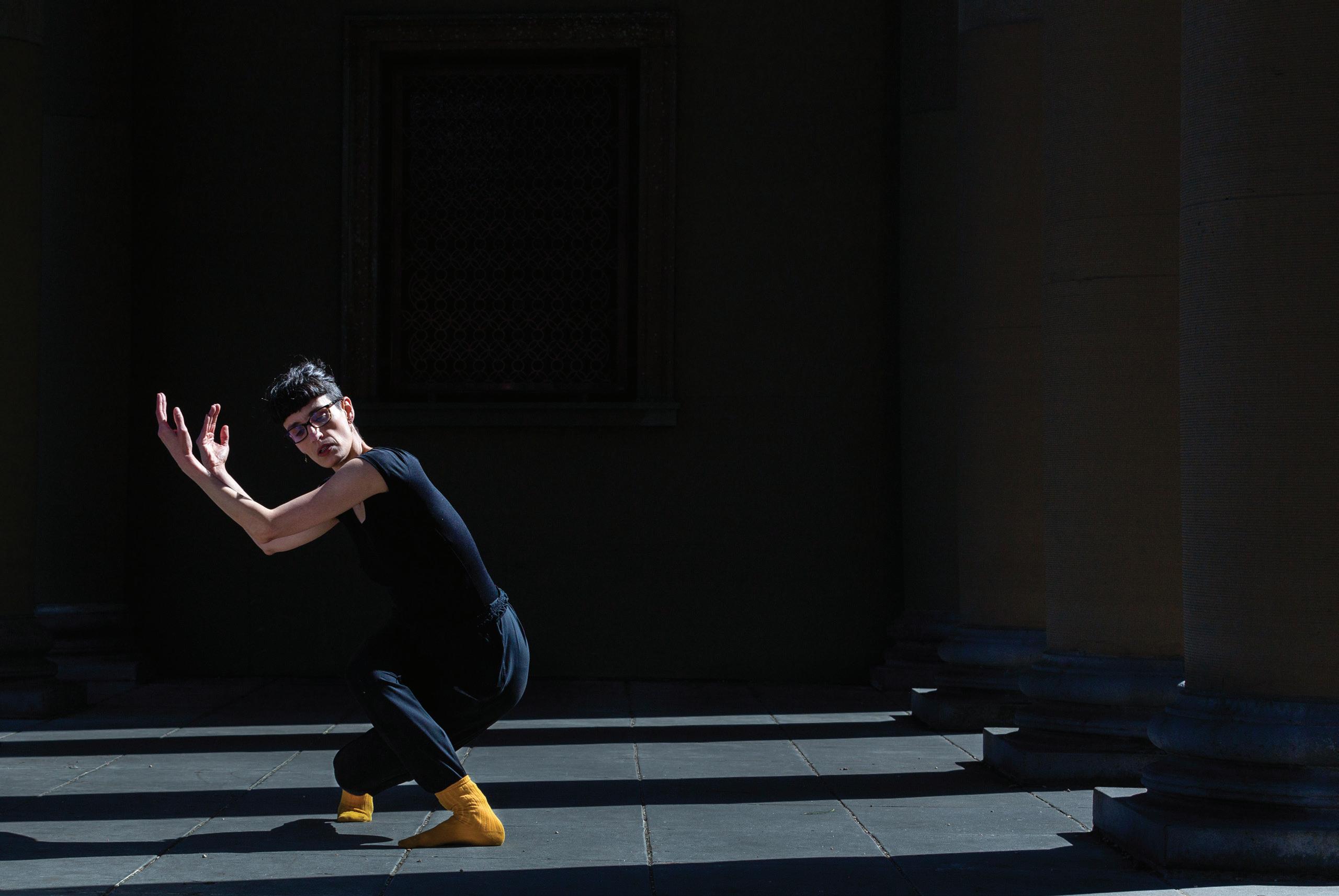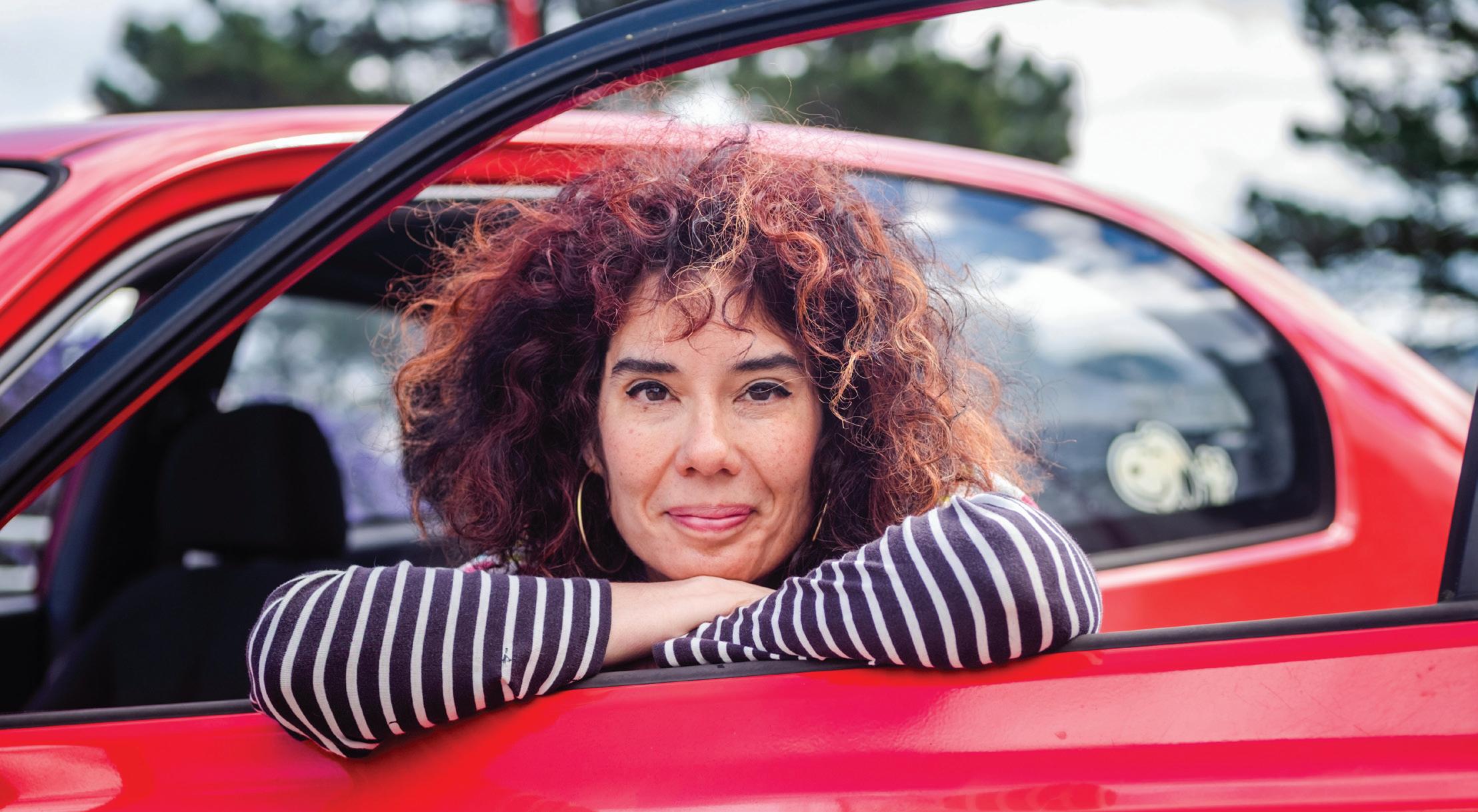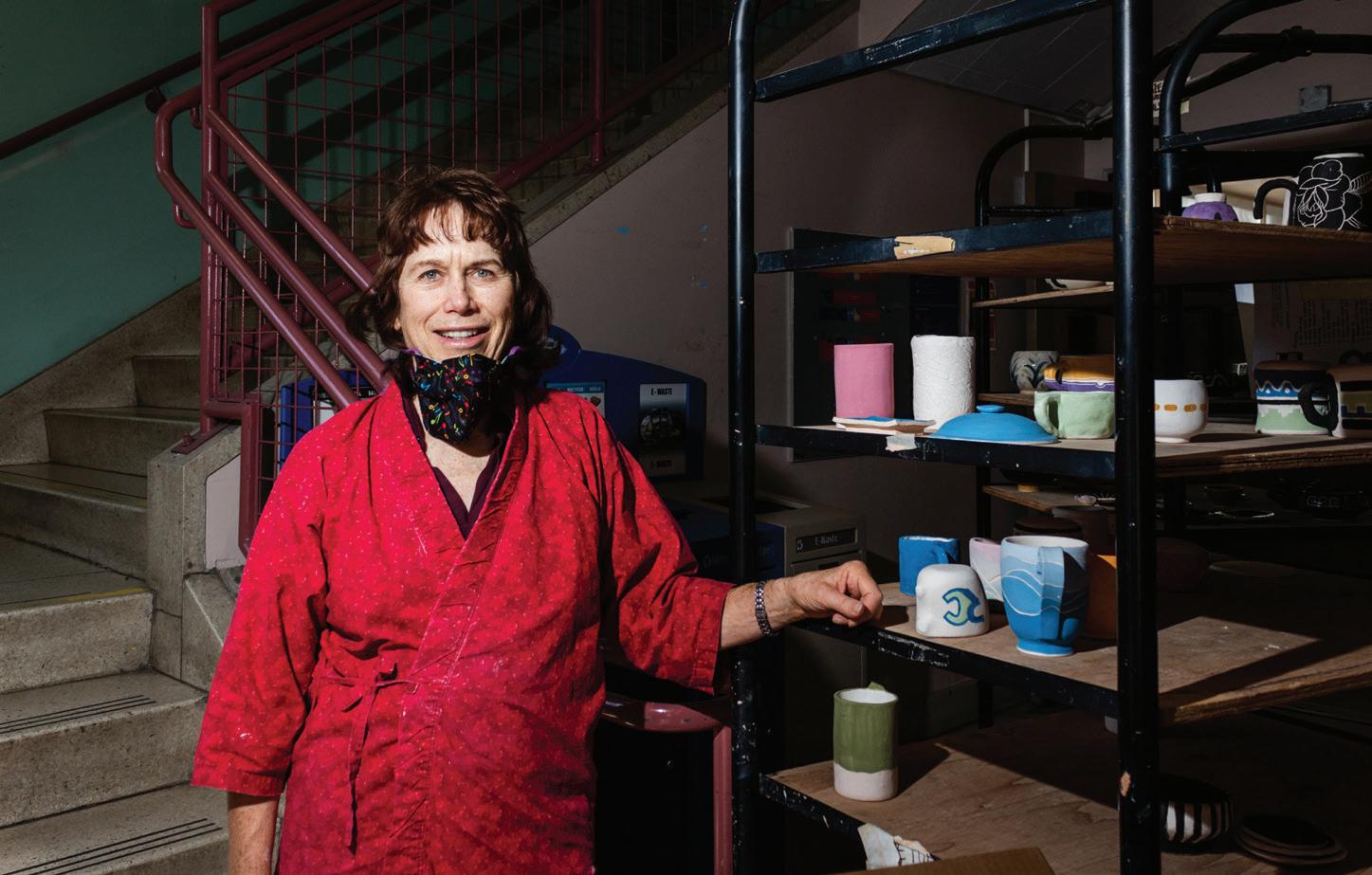
8 minute read
Art Finds a Way

Story by Elizabeth Aranda Photography by Emily Trinh and Kevin Kelleher
Advertisement
Dance student Yosune Camio practices a ballet routine on the side of the Music Concourse in Golden Gate Park. (Kevin Kelleher/Etc Magazine)
Dust bunnies gather around locked cabinets full of unused materials. The once bustling studios at City College of San Francisco sit empty as the COVID-19 pandemic moves past the one year mark.
Students used to flock to these creative oases set up for hands-on courses like printmaking, painting, ceramics and dance. They offered a sacred refuge for students to create art and express themselves. In March 2020, the pandemic closed those refuges, forcing them to suddenly go virtual. Courses that required tangible elements like inkpresses, paint, clay and dance floors moved online. Personal items and supplies were left behind.
A year later artwork still sits in lockers, paint brushes linger in sinks, easels remain shoved against the walls of the painting studios and the springed dance floors collect dust.
The shutdown further impacted an already struggling City College. Former Chancellor Mark Rocha cut over 1,400 classes and over 300 teaching positions during his tenure. The art department, which already ran on a shoestring budget, was cut to a fraction of what it once was.
In 2018, the art department employed 15 full-time instructors and 20 part-time instructors. By the start of fall 2020, the department employed only nine full-time and 13 part-time instructors.
Now in spring 2021, there are currently nine full-time and 15 part-time instructors in the art department. More class and faculty cuts are expected this coming fall.
The dance department, which still includes two full-time and eight part-time instructors, may not exist past this spring semester. All of the part-time faculty have been notified by the department chair that they will have no assignments in fall 2021 because of full time equivalent reductions. Both full-time instructors were issued pink slips on Mar. 3.
“This would effectively mean the elimination of the dance program classes

Pottery designed by Professor Janet Lohr’s students awaits firing outside the Creative Arts Building. (Kevin Kelleher/Etc Magazine)
and certificates,” says Jeanette Male, one They sought ways to adapt to the remote With Zoom classes becoming the new of the two full-timers. “We need to classrooms. Karina Saekow was enrolled normal, painting instructor Elliott has support our faculty to maintain the legacy in art classes at City College before the concerns. “Technology is a barrier for that we have worked to develop over the shutdown and continued with them some students,” she says. She finds it more past 85 years.” during the switch to remote learning. difficult to interact with her students.
Even though the dance department While the transition was difficult, she “They can disappear behind their screens, at City College is smaller due to recent found a way to make it work. She goes so I have to work extra hard to build a budget cuts, class reductions, and faculty to local parks to complete her drawing connection with them.” retirements, “We have upheld our assignments and work on her jewelry The instructors tried to make the standard of instruction,” Male says. designs. Getting fresh air and a change of transition to remote learning as easy
“The cuts are not a reflection of lack of scenery helps stimulate her creativity. as possible, but “The art department had public demand,” says to modify many Art Department Chair Anna Asebedo. “If I never took the art classes that I did at things,” Elliott says. Like many “The systemic underfunding of City College is endangering City College, I would never have realized the potential I had.” — Karina Saekow instructors, Elliott uses Zoom’s breakout rooms the very existence of for students to help its diverse, engaging, relevant, and each other, but she responsive teaching and service resources.” Saekow is grateful to City College feels it is not the best way to teach art.
When the school went to remote for the opportunity to explore her Students no longer receive feedback in learning in spring 2020, painting creative interests. She remembers loving real time. She cannot walk around the instructor Nancy Elliott recalls many of art in elementary school and dreamed studio looking over students’ easels or her students saying they would return of being an artist as a child. “If I never demonstrate the process of mixing oil to art classes in the fall semester. But as took the art classes that I did at City colors on a palette before applying them the pandemic dragged on and the school College, I would never have realized the to the canvas. Once the oils are applied, remained closed, enrollment shrunk. In potential I had,” she says. Saekow plans to there is little room for correction. spite of the bleak outlook and the lack of transfer to San Francisco State University Now students get critiqued only after tangible resources, some painting this upcoming fall semester to continue they have submitted their artwork. They students continued to enroll. her art education. submit their assignments for grading by

Above: Painting Professor Nancy Ellliot looks through her car window while on Ocean Campus. Right: Art student Karina Saekow sits in Golden Gate Park and works on a drawing assignment in which she must study texture. She feels more inspired working outside. (Emily Trinh/Etc Magazine)


A student picks up her pottery at the entrance of the Creative Arts Building. (Kevin Kelleher/Etc Magazine)
Professor Janet Lohr stands next to a cart full of pottery that is ready to be picked up by students at the entrance of the Creative Arts Building. (Kevin Kelleher/Etc Magazine)

taking photographs with their cell phones or cameras and uploading them online.
The change has made Elliott realize how much she loves teaching in a classroom. She cannot wait to be back to in-person teaching even if she is unsure of how that will look.
Ceramics instructor Janet Lohr suggests to her students that they use ordinary at-home items like credit cards or forks in place of ceramic tools. “These are good workarounds, but it is not ideal,” she says.
Ceramics need to be fired in a kiln, which students most likely do not have access to outside of the campus ceramics studios. Lohr arranged a workaround. “Students come to campus a few times during the semester, first to pick up their materials needed for the class, second to drop off their finished artwork to be thrown in the kiln, and then to pick up their work,” she says.
In order to stay safe, everyone wears a mask and keeps a social distance. She takes the ceramic pieces into the enclosed studio to fire by herself before the next scheduled exchange. “When I learned that ceramics would be taught on an online platform, I was apprehensive,” says ceramics student Kalie Taylor. Living in San Francisco means space is tight. “Once I was able to figure out space from the chaos, I dove back into the ceramic making process,” says Taylor. The dance department students struggle with the lack of a physical space too. “There are things that cannot be done at home. We do not have enough room to ‘travel’ while dancing. Most of us don’t have large enough mirrors to see what we are doing,” says dance student Yosune Camio.
“Dancing on a regular floor really limits what we can do...studio floors are sprung to keep your joints safe from impact.” She worries about injury. “At home, the floor is too hard and it may be too slippery.”
She misses the instructor’s presence too. “In the studio, the teacher can see us all throughout the class and give us corrections, but they cannot see us all properly in Zoom, and it is not realistic to provide extensive feedback for each of us.”
Meanwhile, she tries to focus on the positive and considers herself lucky to have the money to buy at-home dance equipment and the luxury to have enough space in her home to practice in peace.
Printmaking student Araceli Nunez has a similar problem. “I have to figure out how to arrange my home to make space for all the materials I need,” she says.
“In the past year I’ve bought a desk, an office chair, a bookcase, and an LED light, but there is no way I can fit more tools like a print press, a scanner, and a lightbox.” She struggles to find space for supplies like inks, paper and tools. She misses her school locker.
At the end of each semester, Lohr has students write essays on how ceramics affects their lives. The responses Lohr receives are heartwarming. Students describe how art has become a salvation for them, a way to cope with the difficulties of life. “When they are having a stressful day and get their hands on some clay, their day goes better. It gives them something positive to focus on,” Lohr says. “I never thought I’d be working on ceramics at home, but I have learned so much during this online period. Letting go of my expectations has let me do the best I can,” says Lohr’s student Joanne Chun.
The online version of the class still inspires Chun. “Clay will continue to bring me joy, provide me with balance and encourage my creativity,” she says.
On a sunny spring afternoon at Stow Lake in Golden Gate Park, Saekow sits on a flannel and her jacket. Soaking in the sunshine and enjoying the change of routine from being indoors, she looks down at her artwork. Adding a few more details to her charcoal drawing of tree bark and leaves, she closes her sketchbook and calls it a day.
Now, three semesters in, despite how difficult learning three-dimensional art is through a two-dimensional screen, online interactive art classes are all some students know. Even without the physical studios, they continue to do what they do best — create.

Professor Lohr arranges pottery that was dropped off by her students. She will fire the pieces then return them. (Kevin Kelleher/Etc Magazine)








